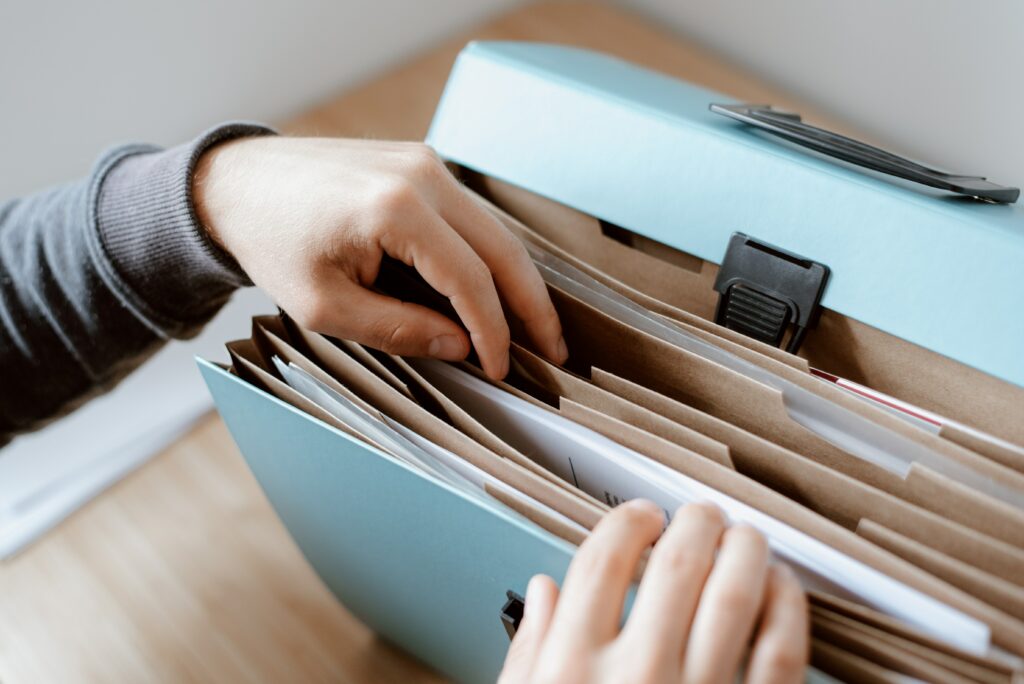Updated February 2025

It’s a new year, the holiday craziness is over and the relative calm of winter is upon us. Sounds like the perfect time to get things done around the house. If you’re drowning in paperwork, now is an excellent time to organize your important documents. Need motivation? Realize that keeping sensitive papers sorted and secure will make it easier to protect your identity. Oh, and tax season is coming.
Create a secure organizational system
Identity theft continues to be a major source of fraud. According to the Federal Trade Commission’s Consumer Sentinel Network, Illinois residents reported more than 31,000 instances of identity theft in 2024 (available data: January – September). Organizing your documents is an effective way to keep your personal and account information secure. Whether you plan to use paper files, go paperless, or rely on a combination of both, it’s important to have a system in place. While there are many different organizational methods, the most important objectives are to keep your system simple, secure and habitual.
Follow these four steps to get your paperwork under control and protect your identity:
1. Gather and sort all your papers. Have you been stashing papers here and there or piling them in a shoebox? Schedule time on your calendar (try two hours) to spread them all out on a large table and sort into categories by importance and immediacy. You can find smart strategies online for categorizing and filing important papers safely. For personal advice and hands-on help, work with a professional organizer.
For a quick sense of accomplishment, start by recycling junk mail or outdated papers. If any of these documents contain account numbers or other sensitive information, set them aside in a secure spot for shredding.
2. Create a straightforward filing system. If your “filing system” consists of a series of random piles of papers scattered across the dining room table or guest bed, you probably aren’t as organized as you think you are. It’s easy for an important or time-sensitive document to be buried and forgotten in an unmarked pile.
Whether you prefer a horizontal (flat or drawer-based) or vertical (traditional filing cabinet or wall pockets) filing system, place all papers into clearly labeled file folders, organized either by subject matter or subject matter plus year (e.g., “Auto Insurance: Toyota” or “2025 Medical: Julie”).
3. Store your documents securely. Place your most important documents in a fireproof lockbox (e.g., birth certificates, will and trust, passport, Social Security card). Keep other sensitive documents in a secure location, such as a locked cabinet (e.g., tax documents, credit card accounts, property papers). You may also wish to scan important documents and keep a digital copy as a backup.
If you decide to go paperless, organize your digital files in the same logical folder structure. Make sure all your digital files are password protected and backed up on a removable storage drive or in the cloud. The Federal Trade Commission offers additional practical tips to keep your personal information secure.
4. Incorporate organization into your routine. Create a temporary holding station or receptacle for incoming papers. (The key word here is temporary. A shoebox is fine, as long as it’s temporary.) Next, schedule a regular time each week (write it on your calendar) to sort and file incoming documents. Make your new routine a habit, whether you decide to sort and file every night, once a week or once a month. Do what is realistic and stick with it.
Take additional measures to protect your identity
Now that you have taken control of your paperwork with a simple, secure and habitual organizational system, consider these additional steps. First, check your credit reports. You are entitled to a free credit report every 12 months from each of the three major reporting agencies. Visit this US government website to learn about credit scores and reports and what to do if you notice something is awry.
Next, investigate identity theft insurance. Several insurance providers offer the option to add identity theft coverage to a homeowner policy inexpensively. This insurance covers costs related to lost wages, legal fees, credit reports, and more. And, as computer hacking and fraud-related financial losses only continue to increase, insurance companies are enhancing their protection options to address the growing demand for cyber liability coverage for individuals.
Benefits also include a professional advocate who can do things like contact the major credit bureaus on your behalf to help correct credit reports, close affected or fraudulent accounts, deal with government agencies involved (such as the Social Security Administration), and keep detailed records throughout the process of restoring your identity. Contact your Bradish agent for help finding the best identity theft coverage for your family.
Just think how relieved you will be once your organizational strategy is in practice. Taking steps to protect your identity will yield peace of mind. With your important documents organized and sensitive information secured, life just got easier.
by Kris A. Mainellis